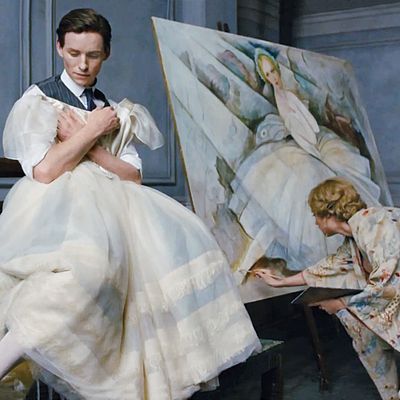
The kindest thing to be said about the high-toned transgender weeper The Danish Girl is that by the time it ends it can serve as a decent liberal corrective to a century of reactionary demon-possession movies. Eddie Redmayne plays Einar Wegener, an acclaimed Copenhagen painter circa 1926 who discovers — after slipping into stockings and a dress to pose for his painter wife, Gerda (Alicia Vikander), when her model is late — that there’s someone else inside him and her name is Lili. In the standard horror formulation, Lili’s threat to swallow Einar from the inside would need to be thwarted by the Church and/or the power of love, or else the LiliMonster would triumph and return in seven sequels. In The Danish Girl, Gerda is certainly devastated by the loss of her husband and, at her most vulnerable, begs Lili for access to Einar. But it is finally Einar who needs to be exorcised, surgically, on the grounds that God (or Whomever) cocked the whole gender thing up.
Although The Danish Girl is based on a novel by David Ebershoff, Lili Elbe (she took her last name from the river) did exist, and her story is so astonishing that I can’t believe I’d never heard it until now. It’s too bad that my introduction had to come through the lens of director Tom Hooper, an Oscar-certified genius at teasing out the banal from the exceptional. Because both Einar and Gerda are painters, Hooper has opted for a painterly, chiaroscuro style, the backdrops dappled, the faces kissed by white light from on high. What Hooper can’t manage is to put us inside his characters’ heads — where we should be in a story that makes every surface suspect.
The screenwriter, Lucinda Coxon, approaches Lili’s life from a gender-psychology perspective, setting up the idea that, as Gerda tells a squirmy male subject, “it is difficult for a man to submit to a woman’s gaze.” Once in a dress and wig, Lili slowly begins to enjoy surrendering to the male gaze — to the point where she has no further desire to paint, her principal work being the realization of her true self. Gerda undergoes a change as well. An unsuccessful portrait painter, she begins to find in Lili a tantalizing subject — a sort of Impressionist’s Mona Lisa.
But here’s where Hooper and Coxon conventionalize the story. There’s nothing in Vikander’s Gerda to suggest why Lili liberates her as an artist, especially when she’s weeping so hard over Einar’s departure. The novel’s Gerda — reconceived by Ebershoff to be less conventionally feminine and called Greta — begs Einar to bring back Lili, not vice versa, and there’s a wonderful twist: The petite, finely turned Lili proves more attractive to men than the taller Greta. Hooper, whose sensibilities seem Victorian, keeps Lili’s sexual longing for men discreetly offscreen, and a potentially romantic relationship with a magnetized suitor (Matthias Schoenaerts) comes off as a throwaway. The script is full of signposts, but Hooper shows no interest in testing the idea that Einar and Lili are mutually exclusive — that one must die for the other to live — or having a little fun with the notion that if clothes maketh the man, they induceth the woman. He does best with the more obvious scenes, with the parade of doctors who want to irradiate, drill holes in, or lock up their riven patient.
Vikander has gotten some extraordinary reviews, probably because she has to carry all her scenes with Redmayne to give them a dramatic motor. It’s not entirely the actor’s fault. The Lili of The Danish Girl is passive, quivery-moist, and inward-gazing, as if womanliness for her meant having no agency. There’s no sign in this fragile martyr of the Lili Elbe who returned to Denmark after a sojourn in Paris and surgery in Dresden and gave interviews to any journalist who’d listen, and who used her little time left to collaborate on a memoir about her external transformation. A master of spiritual kitsch, Hooper is less drawn to her transformation than to her transfiguration.
*This article appears in the November 16, 2015 issue of New York Magazine.


